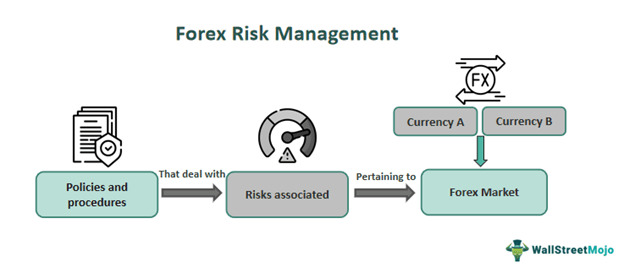Table of Contents
What Is Forex Risk Management?
Forex risk management refers to the processes and strategies employed by traders and investors to identify, assess, and mitigate potential risks associated with foreign exchange trading. It involves prioritizing and implementing measures to protect against adverse market movements and financial losses.

Employing risk management in foreign exchange is essential for safeguarding capital and mitigating possible losses. It involves employing strategies like placing stop-loss orders, adopting appropriate position sizing, and diversifying investments. These strategies allow individuals to shield against substantial financial downturns and sustain profitability over the long term.
Key Takeaways
- Forex risk management is the employment of processes that minimize the risk associated with forex trading.
- It is essential for protecting capital and ensuring sustained profitability. Strategies like stop-loss orders, limiting leverage, and diversification mitigate risks.
- Emotional discipline and adherence to trading plans prevent impulsive decision-making.
- To navigate volatile markets effectively, using risk management tools like stop losses and position sizing can be beneficial.
- A smart trading plan enhances consistency and control in decisions.
Forex Risk Management Explained
Forex risk management entails establishing guidelines and processes to mitigate and reduce the negative impact of forex exchange if a currency pairing fails. The dynamics of supply and demand drive the currency market. Forex markets are classified into three types: spot, forward, and futures markets. An adequate risk management approach is required to control currency movements. Currency valuations are continually fluctuating, making foreign exchange risk management critical for organizations conducting international trade.
Common risks in forex trading include liquidity risk, operational risk, legal risk, market risk, country risk, and social risk.
- Liquidity risk occurs when a currency pair is unavailable, which can be minimized with proper risk management.
- Operational risk is associated with the technology and infrastructure of a trading platform, such as the quality of software and reliance on external networks.
- Legal risk involves violating a country's trade laws, which can be mitigated by using regulated brokers.
- Market risk involves market volatility, economic issues, political instability, and international relations, which can be mitigated through risk and money management strategies.
- Country risk is inherent in trading in a particular currency in a particular country, and it is essential to choose a broker in a country with a stable political and economic environment.
- Social risk is connected to the county's social issues, managed by choosing reputable brokers.
By implementing these risk management strategies, traders can minimize the potential for large losses in trading.
Many traders use Saxo Bank International to research and invest in stocks across different markets. Its features like SAXO Stocks offer access to a wide range of global equities for investors.
Strategies
Some of the strategies that can be useful in mitigating risks are given as follows:
#1 - Developing a Smart Trading Plan
A well-crafted trading plan is essential for effective FX trading since it serves as an individual decision-making tool. It assists in the enforcement of laws and regulations in the volatile forex market. Moreover, it addresses key topics such as when, what, why, and how much to trade. It is critical to personalize a forex trading strategy to individual goals, attitudes, and ideas, as various individuals may have different time and resource constraints.
To manage forex risk effectively, create a trading plan that outlines the opening and closing times, minimum reward-to-risk ratio, and risk percentage. Adhering to this plan consistently helps maintain control over emotions and prevent over-trading. This strategy will help individuals stay informed in the volatile forex market.
#2 - Emotional Intelligence
Forex traders must maintain emotional discipline to achieve consistent profits. Emotional impulses often lead to deviations from trading strategies and rules, resulting in delayed exits from losing trades. Traders need to cultivate patience and wait for genuine trading opportunities rather than acting impulsively. Emotional reactions, such as making larger trades to recover losses or becoming overconfident during winning streaks, increase the risk of substantial losses. Effective risk management strategies hinge on traders maintaining composure and avoiding stress during trading. Thus, traders must prioritize emotional control to adhere to trading strategies and mitigate potential losses.
#3 - Limiting Leverage
Limiting leverage in trading accounts can significantly impact profits and risks. This implies that if the market moves favorably, the full benefit of the trade would be realized despite only a small amount being invested. Conversely, if the market moves unfavorably, exposure to forex risk increases. To effectively manage forex risk, beginners should avoid high leverage, thus curbing their exposure. Comprehending potential losses before employing leverage is crucial to preventing substantial setbacks to the portfolio and shielding against adverse market movements. While understanding risk management in the foreign exchange market is vital, exercising self-discipline becomes paramount when confronted with adverse market shifts.
In addition to the above, individuals shall be mindful of their risk appetite and be clear about the profit they aim to achieve. The key here is not to be greedy and move cautiously.
Examples
Let us look into a few examples to understand the concept better.
Example #1
Suppose Danny, an experienced forex investor, uses a forex risk management calculator to determine the appropriate position size for each forex trade based on his risk tolerance. He conducts thorough market analysis before entering a trade, identifying a potential opportunity to buy EUR/USD. The calculator inputs his account balance, risk percentage, and stop-loss level, providing a recommended position size. If the trade goes against him and the stop-loss is hit, Danny will only lose a predetermined percentage of his account balance.
Danny executes the trade with the appropriate lot size and closely monitors the market, adhering to his risk management strategy. He sets a stop-loss order at a level that aligns with his predetermined risk percentage. After a few days, the market moves in Danny's favor, and the trade reaches its profit target.
Subsequently, Danny identifies another trading opportunity, this time involving the JPY/EUR currency pair. He calculates the appropriate position size based on his risk percentage, account balance, and desired stop-loss level, allowing him to enter the trade with confidence.
Throughout his forex trading journey, Danny maintains discipline and responsible trading practices, preserving his capital, minimizing potential losses, and achieving long-term profitability in the forex market.
Example #2
According to a study conducted by Anthony Durojaiye Mayungbe, the presence of foreign exchange risk has been affirmed. This aligns with previous findings by Collier and Davis, Soenen and Aggarwal, Teoh and Er, etc. This research extends this evidence by applying the concept to the manufacturing industries in the Western Region of Melbourne. The study highlighted that firm size does not affect foreign exchange risk management practices or the use of synthetic products.
The main emphasis of firms lies in actively managing transaction exposure, often overlooking the potential benefits of considering economic exposure. Incorporating the economic exposure concept could facilitate long-term strategic management and maximize value. Hence, firms are advised to adopt the strategic approach advocated by Glaum (1990) for effectively managing foreign exchange exposures.
Importance
Some of the reasons why risk management in forex is important are given as follows:
- Preserves Capital: Effective risk management safeguards trading or investment capital against excessive losses. Using risk management tools allows individuals to protect their capital by avoiding impulsive decisions. These tools help in determining forex risk management lot size and other factors that affect the profit.
- Ensures Consistency: Implementing a uniform approach to trading and investment decisions promotes consistency. Analysis of the forex risk management chart and making decisions based on its help in sustained earning of profits.
- Reduces Emotional Bias: Risk management strategies help diminish impulsive and emotional decision-making, which may result in excessive risk-taking.
- Offers Peace of Mind: Adopting risk management practices instills a feeling of security and confidence amidst uncertain market conditions. Planning and execution are key factors that help a trader employ strategies such as prefixed risk management size, which can give a sense of security for not making irrational decisions.
Disclosure: This article contains affiliate links. If you sign up through these links, we may earn a small commission at no extra cost to you.

